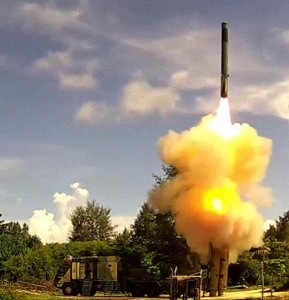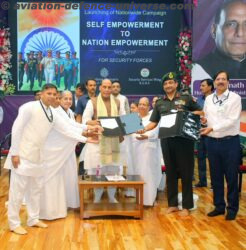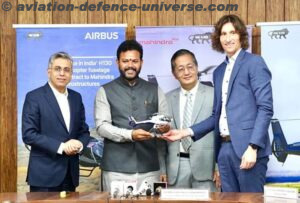
New Delhi. 01 January 2019. DRDO dedicatedly working towards enhancing self-reliance in Defence Systems and undertakes design & development leading to production of world class weapon systems and equipment in accordance with the expressed needs and the qualitative requirements laid down by the three services.
DRDO is working in various areas of military technology which include aeronautics, armaments, combat vehicles, electronics, instrumentation engineering systems, missiles, materials, naval systems, advanced computing, simulation and life sciences. DRDO while striving to meet the Cutting edge weapons technology requirements provides ample spinoff benefits to the society at large thereby contributing to the nation buliding.
Long Range Surface-to-Surface Ballistic Missile ‘Agni-5’: During the year, Agni-5 was successfully flight tested thrice in Jan, June& December 2018. A total of seven flight trials have been conducted so far and all the missions have been successful.
Ballistic Missile Defence (Programme AD): Interceptor missiles have been developed by DRDO as a strategic weapon against ballistic missile attacks. Successful trials of endo- interceptor missile (AAD) and exo- interceptor missile (PDV) were carried out in August 2018 and September 2018 respectively.
Beyond Visual Range Air-to-Air Missile ‘Astra’: Beyond visual range air-to-air missile ‘Astra’ possessing high single shot kill probability has been developed by DRDO to engage and destroy highly manoeuvring supersonic aerial targets. A series of flight trials of the missile by IAF were conducted at ITR, Balasore as part of final development trials of the missile in September/October 2018.
New Generation Anti-Radiation Missile (NGARM): DRDO is involved in the design and development of NGARM having a range of 100 km. AKU-58 launcher after suitable modification will be used for missile integration on Su-30 MKI aircraft. Successful static firing of integrated P-I & P-II rocket motor was conditioned at high & low temperatures in Jun & Jul 2018 respectively. Captive Flight Trials were also successfully conducted in September 2018.
Man-Portable Anti-Tank Guided Missile (MPATGM): MPATGM is a 3rd generation ATGM with ‘Fire & Forget’ and ‘Top Attack’ capabilities, which can be day and night. Design & development of MPATGM weapon system is undertaken for deployment by Infantry and Parachute Battalions of the Army. During the year, sub-systems for control flight trial were acceptance tested and lined up for missile integration which was followed by successful Program Control Flight Trials of the missile system in September 2018.
Stand-off Anti-Tank (SANT) Guided Missile: During the year, SANT Guided Missile mission-01 campaign was conducted during May 2018 at Jaisalmer, Rajasthan during which successful firing of SANT from Mi-35 helicopter platform was demonstrated. SANT Release Flight Trials (RFT) with mathematical model of seeker was also conducted in Nov 2018 wherein safe separation from Mi-35, transfer alignment algorithm, launch release sequence and latex/roll control auto pilot algorithms was demonstrated.
Smart Anti Air Field Weapon (SAAW): SAAW is long-range, stand-off, precision air-to-surface weapon capable of engaging ground targets. Impact trial of SAAW was conducted in May 2018 to access penetration capability of SAAW in full configuration mode. Three tests of SAAW were also carried out during August 2018 from IAF aircraft. The weapon has undergone eight developmental flight trials till date.
Medium Altitude Long Endurance (MALE) Unmanned Aerial Vehicle (UAV) ‘TAPAS BH’: TAPAS-BH, a multi-mission UAV is being developed with an endurance of 24 hours to carry out the intelligence, surveillance and reconnaissance (ISR) roles for the three Armed Forces. It is being designed to operate at 30,000 ft Above Mean Sea Level (AMSL) altitude and is capable of carrying Electronic Warfare and Electro-Optic & Synthetic Aperture Radar (EO & SAR) payloads. During the year, a total of 63 taxi trials (LSTT & HSTT) have been completed. The first block of User Configuration flights commenced in February 2018. As on date, 25 User configuration flight trials have been completed.
Guided Pinaka Rocket System: Guided Pinaka Rocket system is being developed by DRDO to engage targets from 20 km to 80 km range. The rocket uses propulsion system developed for Pinaka Mk-II rocket and has canard based aerodynamic control and Inertial Navigation System (INS)/Global Positioning System (GPS) based guidance. The system was successfully test fired from PXE, Chandipur in May 2018 and met all its mission objectives.
New Family of Munitions (NFMS): Six types of munitions are being designed and developed by DRDO viz. Soft Target Blast Munition ‘NIPUN’, Anti-Tank Point Attack Munition ‘VIBHAV’, Anti-Tank Bar Munition ‘VISHAL’, Directional Fragmentation Munition ‘PARTH’, Anti-Tank Munition ‘PRACHAND’ and Jumping Fragmentation Munition ‘ULKA’ to improve the existing munitions and enhance its performance. During the year, PSQR based User Trials of PRACHAND was completed.
Arjun Armoured Recovery and Repair Vehicle (Arjun ARRV): ARRV is intended for carrying out recovery, repair and replenishing functions pertaining to MBT Arjun in operational areas under a wide variety of field conditions. During the year, 1st prototype was successfully demonstrated during DRDO internal trials and 2nd prototype is under developmental trials.
Advance Light Towed Array Sonar (ALTAS): ALTAS is an efficient sensing system for detection, localization and classification of submarines operating especially in the below surface layer ocean conditions. It is useful in Anti-Submarine Warfare (ASW) operations and is the apt sensor for warships to locate silent submarines capable of launching high speed torpedoes. User Evaluation Trials of the system on board INS Sharda are under progress. Almost 75 NSQR parameters including parameters pertaining to towing characteristics and functions of launch/recovery unit have been demonstrated during the trials.
USHUS – 2: USHUS-2 is submarine sonar to be installed onboard four EKM submarines considering the long term requirements of the submarine arm and to combat the component obsolescence in the existing Russian sonars on board these submarines. Design and development of engineered model of USHUS-2 is carried out in NPOL and produced at M/s. BEL, Bengaluru. During the year, Sea Acceptance Trials (SATs) Phase-1 of USHUS-2 on board INS Sindhukesari was completed successfully in Russia.
Portable Diver Detection Sonar (PDDS): DRDO/NPOL is involved in the design and development of a PDDS system that is capable of detecting small targets such as divers and diver delivery vehicles in and around harbours. It will be deployable and retrievable as and when required. During the year, PDDS deployment system has been developed. Field evaluation of the deployment system will be by early 2019.
Advanced Light Weight Torpedo (ALWT): ALWT is an anti-submarine torpedo launched from ship, helicopter or fixed wing aircraft. It has dual speed capability and endurance of 25 km at low speed (25 knots) and 12 km at high speed (50 knots). During the year, discharge test of 70 kw battery was conducted with full torpedo assembled. Static test was conducted at sea off Vizag to prove operation of recovery aids used in ALWT viz. STRS, IPRS, Noise maker and BSAT. Automated electrical firing of it from single tube launcher and dynamic sea trials was conducted wherein torpedo made full run as per mission sequence.
Software Defined Radio (SDR): The development of a family of network-enabled, interoperable and modular SDRs is to provide wireless secure communication capability to both mobile and fixed forces as required by the Navy are: Naval Combat (SDR-NC), Tactical (SDR-TAC), Airborne (SDR-AR), Manpack (SDR-MP) and Hand held (SDR-HH). During the year, Acceptance Test (ATP) and User Evaluation Trials of SDR-TAC were completed on five ships at Vizag. Flight trials of SDR-AR for selected bands were also completed.
Air Defence Fire Control Radar (ADFCR) ‘Atulya’: ADFCR ‘Atulya’ in conjunction with anti-aircraft guns, forms a ground based air defence system whose main purpose is effective point defence against all air threats at short and very short ranges during day and night. During the year, DRDO evaluation of the radar system was completed and integrated test firing of ADFCR with guns and targets were carried out.
Air Defence Tactical Control Radar (ADTCR): ADTCR has been developed for Army AD for surveillance, tracking and Identification of Friend/Foe (IFF) of aerial targets and transmission of data to multiple Air Defence command posts/weapon systems. During the year, DRDO internal evaluation of ADTCR system was completed. All the PSQR parameters were complied and verified by demonstration/analysis. The system is ready for User trials.





























































































































